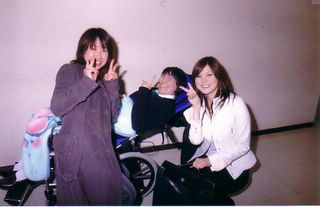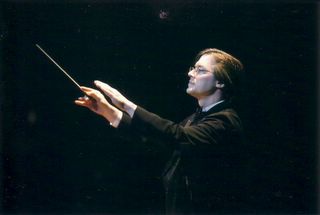Week One, Day 5: Same Song, Second Verse
Wednesday morning arrived, and I dutifully got up, got myself together, gathered up my rather intimidating collection of necessities, and headed off once again for Kashima Rousai Hospital.
Our cat, Mint, had slept under my bed the night before and seemed irritated when I discovered her that morning. Apparently she'd thought herself well hidden, but as she shares my affliction of a perpetually sniffly nose, secrecy is pretty much impossible. The weird thing is that she'd never done that before. No, actually, what was really weird was that the day before had been the first anniversary of the death of my in-laws' cat, Mi, whom Mint resembles. Mint showed up on our doorstep (as Mi had shown up on the in-laws' doorstep 14 years before) about six months after Mi died and freaked everyone out. That's why she was named Mint. Anyway, for some bizarre reason, Mint spent most of the day camped in front of Mi's grave and was reluctant to leave. After leaving her hiding place under my bed and having her breakfast, she followed me out as I headed for Rousai and immediately went to Mi's grave again.
Yes, I know I've digressed, but I had to wonder if it was an omen or something.
Traffic was light, since it was well past the morning rush hour, and I made it there with skads (si*) of time to spare. That gave me some time to relax and read a bit more of Bill Wyman's Stone Alone before throwing myself into the system again. When it finally came close to H-hour, I scooped up my insurance folder and the envelopes containing the X-ray and CaT scan films from Koyama Memorial, tossed my briefcase into the back of my BLUE car, and went into the reception area.
One of the neat things about modern Japanese hospitals is that reception has been made so efficient and convenient. If it's a repeat visit, all you have to do is go up to a thing like an ATM machine and stick your card in the slot. You get checked in automatically, and you proceed directly to your appropriate department. No fuss, no mess, no long lines, and no airheaded, orange-haired snob talking to you patronizingly in incomprehensible, honorific-laced, polite language.
Naturally, my card didn't work. I stuck it in the slot and got nothing but an obnoxious-sounding, electronic bleep that was obviously designed to insult and embarrass you while at the same time advertising your dumb fool status to everyone in the wing.
Ducking behind a pillar, I examined my card closely and realized I had tried to use the one for Koyama Memorial by mistake. (I didn't even realize they'd made one, considering it was obviously a one-shot emergency visit!) Sighing, I began digging through the pile of amassed hospital cards and realized to my dismay that the one for Rousai wasn't there. When I'd come in before, my loyal, loving wife had taken care of all the technical stuff for me. Today she couldn't come, so I was on my own, but she'd told me she'd put all the stuff I needed together. Apparently her definition of "together" and mine are a bit different. At any rate, there I was, more than an hour from home, five minutes from my appointment, with no card and no appointment ticket.
The airheaded, orange-haired snob at the counter made me a new card, confirmed my appointment, checked me in, and informed me patronizingly in barely comprehensible, polite, honorific-laden language that there would be a surcharge for the replacement card. When I told her I had no idea where I was supposed to go (since my wife had made the appointment instead of me) she grabbed a map from a nearby pile and impatiently circled the urology department.
"Ah, urology," I said. "Not X-ray. Got it."
I started to walk away, but the receptionist thrust the paper in front of me and said, "No, please keep it." Then, with an air of polite "get out of my &#%$ face" finality, she quickly told me the way to the urology department. Mindful of the stares (and grins) behind me, I moved with decided haste.
Man, I love appointments! When I got to the urology department, I sat down for a grand total of two minutes before my name was called and I was sent off to the X-ray section for a CaT scan.
Rousai's CaT scanner was an older model than the one at Koyama Memorial. In other words, there was no cute, female, electronic voice telling me when to hold my breath. However, the machine was a lot larger, and the scan session took a lot less time to produce the same results.
I returned to urology, where I was made to sit for a grand total of five minutes before being called in. (I LOVE appointments!!!)
The urologist had the prints from Koyama Memorial and the ones from Rousai set up side by side for comparison. He pointed out the differences with nauseating clarity. Basically, it was something along the lines of, "This thing that looks like a misshapen golf ball was your lower-right kidney this morning. This thing over here that looks like a half-inflated beach ball was the same kidney last Saturday. In other words, that's why it hurt like an SOB. Any questions so far?"
No, I don't think so. It's all crystal clear.
However, that wasn't the end of the discussion.
The stone was still there. Unfortunately, it was also in a very inconvenient place. It had indeed passed a lot further down the track, but now it was apparently lodged in a nice, secure, little pocket where it could be seen with a CaT scan easily but not very well with a regular X-ray. In other words, that evil, little stone thought it was hiding...just like my cat had that morning.
I guess I have my own psychic cat scanner. (Alright, enough of that...)
I was then told what needed to be done about it, and it all sounded very, very, very familiar. The doctor's recommendation was to continue my current tube-dilating medication for a couple more weeks to see if the little bastard would work its way out on its own. If that didn't work, step two would be to [too icky to talk about...especially since I've already been through it once]. If that turned out to be unworkable, I might face the prospect of surgery. Again.
I'll say this much, though. At least Rousai has kept the tests short, sweet, and to the point while explaining the reason for everything along the way. (At Kaiser, back in 1984, they just kept sending me to all these wicked ordeals without a word about it. I got the feeling they were just trying everything for the sheer sake of trying it.) There has also been a comforting lack of people staring at me like a laboratory rat in the process. At least this time there is a very definite stone showing up in the scans. That gives me hope, since they couldn't find anything at all at Kaiser until they cut me open...and then the problem turned out to be a very esoteric one. This time they know exactly what the problem is, and that simplifies things immensely. It's just getting to it that's the problem.
I guess I'll find out in a couple of weeks. Meanwhile, I've got to put up with this tight, pulling feeling and occasional needle-pricks of pain in my lower right side. Oh, well. Worse things happen in the world, like spontaneous human combustion or getting invited to gala dinners with bureaucrats.






